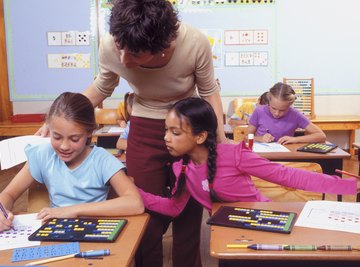
Not all children learn the same way, and math teachers must take into consideration several learning styles to reach most students. Gone are the days when the math teacher stands at the board and completes examples of problems that students will see as class work or homework. Also conspicuously absent are students bent over math worksheets or page after page of math problems. The modern-day math classroom is interactive and hands-on. In addition to presenting mathematical concepts visually and orally, teachers must extend their teaching to another significant portion of the learning population: the kinesthetic learner who must move around and touch objects to grasp elusive concepts.
Cards and Dice
Reaching out to kinesthetic learners does not have to stretch the school’s budget. Inexpensive items such as regular playing cards and dice can serve as instruments of learning. Students review addition and multiplication facts by dealing two regular playing cards and performing mathematical operations on the numbers found on the cards dealt. Dice can be used in much the same way. The familiar card game, Go Fish, helps younger learners identify numbers.
Flash cards often can be found in an elementary teacher’s math supply closet, and allow kinesthetically oriented students a chance for motion. Teachers also often play “Around the World” with students to review math facts. Students enjoy the movement and the competition, while teachers revel in the increase in the class's automatic math fact recognition.
Using Manipulatives
Some math textbook companies include a classroom set of math manipulatives. These manipulatives are objects that can be handled to enhance the math experience, and vary depending on the math level. Manipulatives include blocks and number lines for counting and performing simple math operations; spinners, marbles and double-sided counters for work with probability and ratios; clocks for telling time; and fake paper money and coins for units on counting and changing money. Teachers use these manipulatives to transform abstract mathematical concepts into concrete activities.
Computer Time
Students always enjoy time on the computer, so computer time can be effective during a math lesson. If the classroom computers have internet capability, bookmark math websites that allow students to play interactive games corresponding to your math lesson. Additionally, some math textbook kits include a CD containing math programs. Use this software to reinforce math concepts such as addition, subtraction, multiplication and division. More sophisticated software programs exist for students to practice graphing techniques and solve complicated word problems.
Food Math
Bring in fruits such as apples, pears and oranges to introduce lessons on fractions. Demonstrate fractions by cutting different portions of the fruit into common fractions, such as:
- halves
- thirds
- quarters
- fifths
- sixths
At the end of the fractions unit, reward your students for their hard work by having a pizza party or pie tasting. Split the pizzas or pies into various sections to review fraction concepts with your students before allowing them to consume the food.
Scavenger Hunt
Let your class run wild during math time. With lessons on two-dimensional and three-dimensional shapes, engage your students in a treasure hunt around the classroom. After ensuring your students have become familiar with each of the shapes in your lesson, provide students with a list of shapes you want students to find within the classroom. This activity gets your students moving, touching objects and exploring shapes in a tangible way.
Act It Out
Arguably, one of the most difficult areas for students in math is solving word problems. Although word problems should reflect real-world mathematical conundrums, many of the word problems seen in textbooks mean nothing to the student. Have groups of students create skits in which they act out a mathematical problem and solution related to the concept being studied. For example, to illustrate the concept of subtraction, students can perform a skit in which they borrow supplies from one another. This strategy gets students out of their chairs, translates words into actions, and draws relationships between math and students' everyday lives.
References
About the Author
Ho-Diep Dinh has been writing since 2005. She is a contributing writer on eHow and Answerbag, specializing in topics such as human health and the prevention and treatment of diseases. Dinh received her Bachelor of Science in physiology from the University of California at Davis.
Photo Credits
Pixland/Pixland/Getty Images
